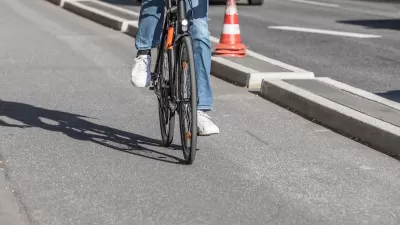In the final installment of his series on "Walking in America" on Slate, Tom Vanderbilt looks at why so much of the built environment is hostile to pedestrians, and how planning can change that.
It's not just enough to encourage people to walk: as Tom Vanderbilt shows, decades of planning for high-speed automobility have made walking almost impossible in some parts of metropolitan areas.
"A large part of the problem is that places...were built on the idea that there wouldn't be anyone walking on them. Indeed, there wouldn't be much of anything happening on them, except for cars speeding uninterruptedly from one dense town to another. This was the vision articulated by early optimists like Benton MacKaye and Lewis Mumford, who sounded their call for such roads in a 1931 Harper's article called 'Townless Highways for the Motorist.' Not only should highways avoid the centers of towns, they argued-in order to keep long-distance traffic from congesting already-busy urban thoroughfares- but those highways should themselves be free of commercial development.
[But] the high-speed suburban arterial became a kind of American Main Street...What's more, these arterials were typically built without any provisions for people walking-because who would be? [Pedestrians] are as invisible to society as they are to the average driver. This failure to plan for anyone on foot is just one of a number of shortcomings of our overbuilt, undermaintained road network that are coming into relief."
Instead of laying streets and planning for sidewalks later -- as has been the practice in many developments - Vanderbilt shows how more than 300 municipalities are now planning for "complete streets" that facilitate multiple modes including walking.
FULL STORY: Learning To Walk

Alabama: Trump Terminates Settlements for Black Communities Harmed By Raw Sewage
Trump deemed the landmark civil rights agreement “illegal DEI and environmental justice policy.”

Planetizen Federal Action Tracker
A weekly monitor of how Trump’s orders and actions are impacting planners and planning in America.

The 120 Year Old Tiny Home Villages That Sheltered San Francisco’s Earthquake Refugees
More than a century ago, San Francisco mobilized to house thousands of residents displaced by the 1906 earthquake. Could their strategy offer a model for the present?

In Both Crashes and Crime, Public Transportation is Far Safer than Driving
Contrary to popular assumptions, public transportation has far lower crash and crime rates than automobile travel. For safer communities, improve and encourage transit travel.

Report: Zoning Reforms Should Complement Nashville’s Ambitious Transit Plan
Without reform, restrictive zoning codes will limit the impact of the city’s planned transit expansion and could exclude some of the residents who depend on transit the most.

Judge Orders Release of Frozen IRA, IIJA Funding
The decision is a victory for environmental groups who charged that freezing funds for critical infrastructure and disaster response programs caused “real and irreparable harm” to communities.
Urban Design for Planners 1: Software Tools
This six-course series explores essential urban design concepts using open source software and equips planners with the tools they need to participate fully in the urban design process.
Planning for Universal Design
Learn the tools for implementing Universal Design in planning regulations.
Clanton & Associates, Inc.
Jessamine County Fiscal Court
Institute for Housing and Urban Development Studies (IHS)
City of Grandview
Harvard GSD Executive Education
Toledo-Lucas County Plan Commissions
Salt Lake City
NYU Wagner Graduate School of Public Service





























